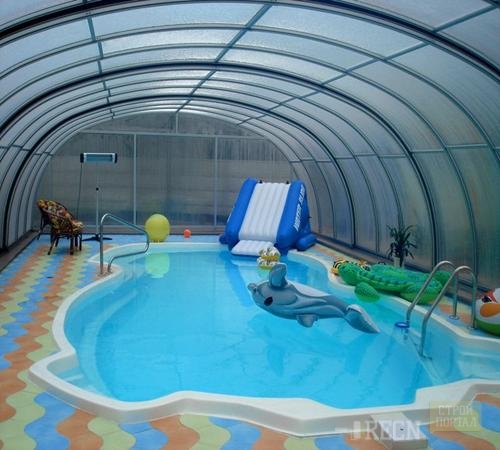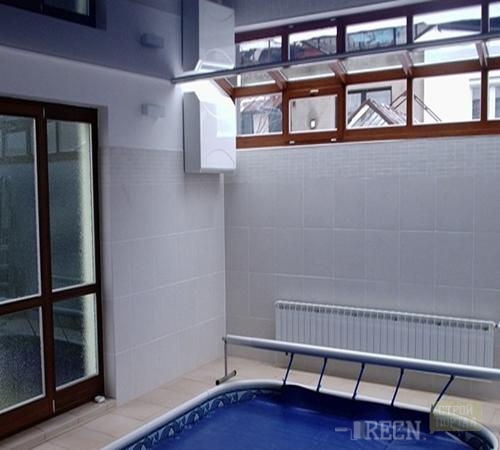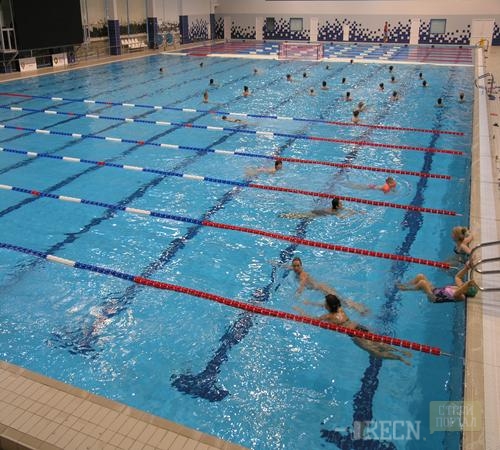
Ventilation system for the pool. What to choose Climate

To date, wealthy owners of country houses are increasingly wanting to have in their territory not only a sauna or bathhouse, but also their own pool. But few know that to create an optimal microclimate in it, at the stage of drawing up a project, it is necessary to take care of the ventilation system, because It is she who provides a comfortable stay in the pool at any time of the year.
Content
Basin ventilation value
It is best to equip the pool with your own ventilation system, separate from the whole house. There are several reasons why such a need arises:
- indoors where the pool is always very humid, because the process of evaporation of water goes continuously;
- usually in the pool and in the house, different temperatures are provided in the ventilation systems: it is always higher in the pool;
- most often, the ventilation of the pool and at home works in various modes.
Installed in the basin, the ventilation system performs the following functions:
- provides the removal of wet air. It does not allow to wet the walls, develop damp, begin the processes of design destruction;
- supplies fresh air people in water;
- creates a certain microclimate in the pool, provides an optimal moisture level and a comfortable temperature;
- saves electricity.
Calculation of the basin ventilation system
There are several types of ventilation systems for pools:
- air Dryer;
- integrated installation;
- supply-exhaust;
- supply-exhaust with dryer function.
To decide which system to give preference, you need to make a competent calculation, relying on the following data:
- layout and technical parameters of the room;
- the presence and condition of heaters;
- calculation of air exchange and the amount of moisture released.
It is also necessary to take care of the installation of the air ventilation system, choosing automatic equipment, sensors, etc.
To make the calculation of ventilation, it is necessary to own special knowledge, comply with certain SNIP standards, have appropriate skills. Therefore, for this service it is better to contact the specialists and not risking the entire system, trying to save a little, counting all the parameters on your own.
Types of ventilation systems
1. The air dryer in the pool is an installation inside which the freon circulates, providing the optimal level of moisture content in the air by draining it. It is equipped with a hydrostat that allows you to set the desired humidity level, which will be supported by independently turning on and off the device. The case of the dryer is made of water-repellent materials, and all connections are sealed. The device sucks air masses, condenses moisture and merges it, and dry, heated air releases back to the room. Desiccant models differ in power and performance, as well as on the principle of operation:
- drainage with the help of adsorbent. Inside the dryer, in a special chamber, there is an absorbent substance that absorbs moisture from the incoming air. Next, the device sends it back to the room;
- assimilation. Dehumidifiers working on this principle are rarely used for pools. They are inconvenient, because dependent on the ambient temperature is not economical in terms of electricity consumption and at the same time they have a small productivity;
- condensation. The steam present in the atmosphere is assembled on a special surface having a lower temperature. The fan drives air containing moisture to the evaporator. It is cooled, moisture condenses and flows into the tank. After that, the air heats up in the condenser and arrives back to the pool.
2. The suppress and exhaust ventilation of the pool not only sends fresh air into the room, but also displays the room spent beyond the boundaries. Thus, two tasks are solved:
- preventing the wetting of the walls of the building due to the drop-down moisture;
- providing people with air, in quantity sufficient for free breathing.
In addition, the system evenly distributes air flow throughout the basin, and various smells with absorbable air eliminates the air.
High-quality air exchange is possible only with proper air distribution in the process of supply and exhaust ventilation in the pool.
Passionate air, warmer and less wet, circulates over the walls and windows, covering the entire perimeter of the room. Thus, the wet air is absorbed very effectively, the temperature of the walls exceeds the dew point.
If the roof of the pool is made of glass, then part of the air is necessary to direct the jet along it.
The flow rate of the supply system and the amount of air outlook should be approximately at the same level. A small difference is allowed to ensure the ventilation system. Due to this, air penetration from the ventilated room in the surrounding rooms is not allowed.
To save electricity, the supply and exhaust systems are installed with heat recovery. Support and exhaust air masses move along two channels through the heat pump. Depending on the current season, it either cools, or heats the trimming air with cold or heat of exhaust air. Such a system allows to spend 60-85% less energy than during the operation of an ordinary supply-exhaust system. In addition, such an installation clears the air flow from dust and has the ability due to the built-in heater, additionally warm the air during the period of severe frosts.
1. Supply-exhaust installation with air drainage. Such a system is even more efficient, because at the same time provides ventilation of air in the pool, and its drainage. The ventilation system ensures people sufficient for comfortable location in the room with the amount of air, and the system responsible for its drain absorbs moisture. Such an installation with its high efficiency allows energy and does not cause drafts. It happens two types:
- with a separate air dryer. On the one hand, such a system is more expensive than the system with a drain function, but in the process of work, it can significantly reduce the cost of electricity. Such a system usually equip small pools in private houses;
- with built-in air dryer. This system is usually mounted in large basins and water parks. In addition to drainage, it includes the functions of heating and cooling, heat recovery. The system allows you to use different layout options, thereby allowing the opportunity to adjust the individual characteristics of a particular room.
2. Complex settings are not only dried and air is ventilated, but also heated the room and heat water. They operate automatically, in accordance with the specified parameters.
Based on the frequency of use of the pool and the current time of the year, the system itself includes the mode of the greatest energy savings. Complex installations may have different performance, so they are selected for the size of a particular pool. They are quite expensive, in comparison with the options described above, but are economical, almost do not need control from human and perform several necessary functions at once.
How to make a choice of ventilation device
Before making a choice in favor of a particular device, it is necessary to calculate the water surface area in the pool. If it is within up to 40 sq. M, there will be enough single air dryer. If the water surface area is from 40 sq.m, then a more powerful device built into the ventilation system will be required. The best solution in this case will be a supply and exhaust ventilation with air drain function.
If the surface of the water in the pool has an area of \u200b\u200bup to 150 sq. M., It is best to prefer the built-in industrial desiccant. Such installation will decide immediately a set of tasks for the improvement of ventilation and drainage.
Also in the premises of the pool, wall and floor dryers can be used, but it is impossible to forget that the built-in is much more effective, because They carry out the process of drainage in the ventilation system, and not in the pool room.
Even more effective is the supply and exhaust ventilation with air drainage. It is universal and simultaneously with the removal of the used air masses, it serves fresh, dry and heated air. At the same time, it is compact, has good noise insulation, does not require a separate room for mounting.


























